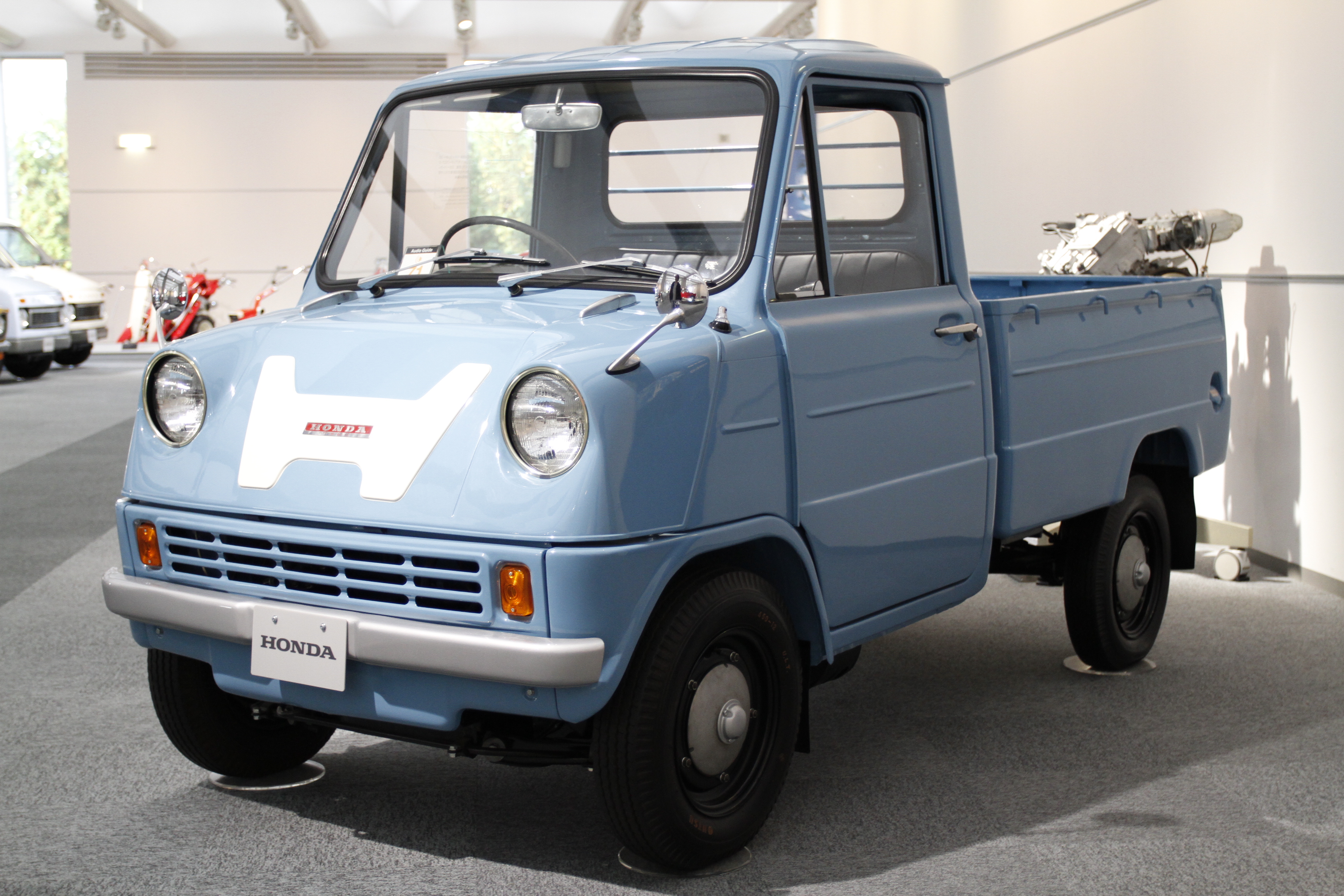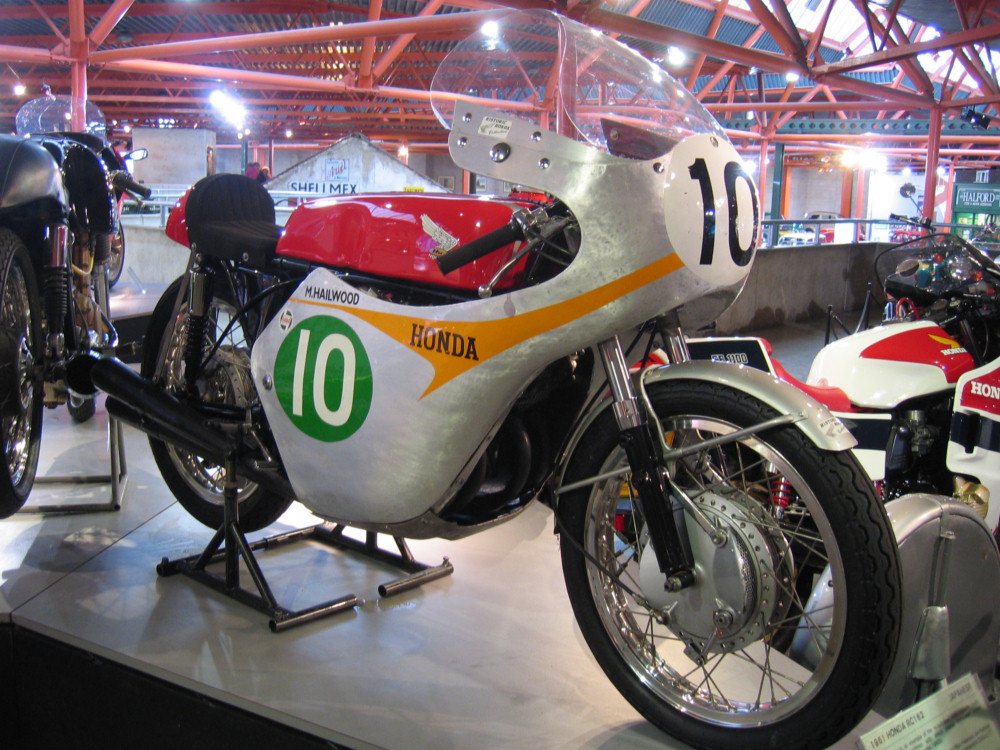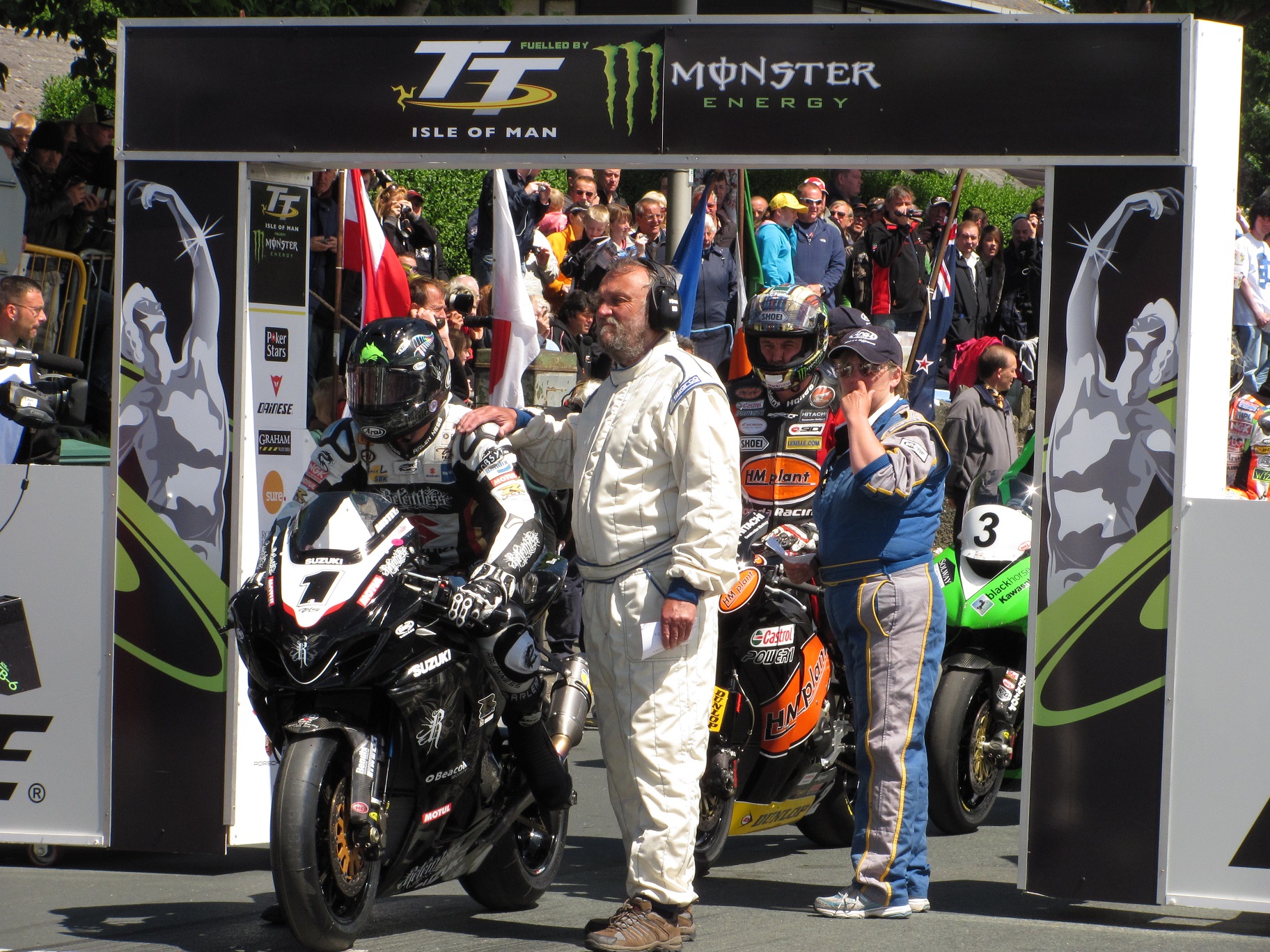|
Honda In Motorsport
Honda has been competing in a variety of racing series through the years, including Formula One, IndyCar, touring car racing, sports car racing and MotoGP. Currently they are involved in Formula One, MotoGP, WTCR, Super GT, Super Formula, IndyCar, IMSA, BTCC, TC2000, Formula 3, Formula 4, off-road, WSBK, EWC, MXGP, TrialGP and various different GT3 and TCR series. Early history In 1954 the founder of Honda, Soichiro Honda, declared that the company would enter the Isle of Man TT in Grand Prix motorcycle racing. The machines were being developed for the next five years, and they would enter the event in 1959 with the RC142 bike. They took 6th, 7th, 8th and 11th place in the race, capturing the Manufacturers' Team Award. In 1961, Honda would take victories at the Isle of Man TT, as Mike Hailwood won two of the races with Honda. They would also win the 250cc and 125cc class titles in the 1961 World Grand Prix season. In 1962, Soichiro Honda decided to enter Formula One. Afte ... [...More Info...] [...Related Items...] OR: [Wikipedia] [Google] [Baidu] |
Honda
is a Japanese public multinational conglomerate manufacturer of automobiles, motorcycles, and power equipment, headquartered in Minato, Tokyo, Japan. Honda has been the world's largest motorcycle manufacturer since 1959, reaching a production of 400 million by the end of 2019, as well as the world's largest manufacturer of internal combustion engines measured by volume, producing more than 14 million internal combustion engines each year. Honda became the second-largest Japanese automobile manufacturer in 2001. In 2015, Honda was the eighth largest automobile manufacturer in the world. Honda was the first Japanese automobile manufacturer to release a dedicated luxury brand, Acura, in 1986. Aside from their core automobile and motorcycle businesses, Honda also manufactures garden equipment, marine engines, personal watercraft, power generators, and other products. Since 1986, Honda has been involved with artificial intelligence/robotics research and released their ASIMO rob ... [...More Info...] [...Related Items...] OR: [Wikipedia] [Google] [Baidu] |
Motocross World Championship
FIM Motocross World Championship is the premier championship of motocross racing, organized by the Fédération Internationale de Motocyclisme (FIM), divided into two distinct classes: MXGP and MX2. Race duration is 30 minutes plus two laps per race. The series runs 18 events with two races per class at each round. History The FIM Motocross World Championship is a worldwide motocross series sanctioned by the F.I.M. It was inaugurated in 1957 using a 500 cc engine displacement formula. In 1962 a 250cc class was added and in 1975, a 125cc class was introduced. Prior to 1957, the championship was known as the European Championship. In 2004, the F.I.M. changed the displacement formulas to reflect the changes in engine technology and as a move towards environmentally friendlier four-stroke engines. The new MX1 class became the premier class, allowing two-stroke engines of up to 250cc and four-stroke engines of up to 450cc. The MX2 class allowed two-stroke engines of up to 125cc an ... [...More Info...] [...Related Items...] OR: [Wikipedia] [Google] [Baidu] |
Honda RA272
The Honda RA272 was a Formula One racing car designed by Yoshio Nakamura and Shoichi Sano for the 1965 Formula One season. It was the first Japanese car to win in Formula One. Concept A successor to the Honda RA271, the RA272 was noticeable mainly for its technically advanced (though rather wide and heavy) 48-valve 1,495.28 cc V12 engine (58.1 x 47.0 mm), a water-cooled, transversely mounted unit which reportedly gave at 13,000 rpm. The engine was safe to 14,000 rpm, which was unusually high for a 1960s engine design. Racing history For their second season in 1965, Honda signed Richie Ginther – who had scored multiple podium finishes and had a reputation for being a great test and development driver – to drive alongside Ronnie Bucknum. The car made its debut at the second round of the season in Monaco. The race ended in a double retirement as the cars suffered gearbox and transmission issues. Ginther qualified fourth at the next race in Belgium, and finis ... [...More Info...] [...Related Items...] OR: [Wikipedia] [Google] [Baidu] |
Honda RA271
The Honda RA271 was Honda's second Formula One racing car, and its first to actually enter a race. The chief engineer on the project was Yoshio Nakamura, with Tadashi Kume in charge of engine development. It was driven in three races during by American driver Ronnie Bucknum. The car was developed from the company's 1963 prototype, retrospectively designated RA270. It was developed around Honda's revolutionary F1 engine, a 1.5 L V12, at a time when V8s dominated the F1 paddock, as constructed by BRM, Climax, Ferrari and ATS. The only other major manufacturer deviating from the received V8 wisdom were Ferrari, who experimented with both V6 and flat-12 layouts, although they ultimately elected to stick with their V8. No other manufacturers were running V12s at the time. The RA271 made its race debut during the 1964 Formula One season, just one year after Honda started producing road cars, and was the first Japanese-built car ever to enter a round of the FIA Formula One Worl ... [...More Info...] [...Related Items...] OR: [Wikipedia] [Google] [Baidu] |
1964 German Grand Prix
The 1964 German Grand Prix was a Formula One motor race held at Nürburgring on 2 August 1964. It was race 6 of 10 in both the 1964 World Championship of Drivers and the 1964 International Cup for Formula One Manufacturers. The 15-lap race was won by Ferrari driver John Surtees after he started from pole position. Graham Hill finished second for the BRM team and Surtees's teammate Lorenzo Bandini came in third. The race was marred by the death of Dutch gentleman racer Carel Godin de Beaufort during practice. The embankment at the ''Karussell'' had been eliminated and replaced with grass and a wheel-wide tarmac strip at the bottom of the concrete banking. Classification Qualifying Race Championship standings after the race ;Drivers' Championship standings ;Constructors' Championship standings * Notes: Only the top five positions are included for both sets of standings. References External links 1964 German Grand Prix at statsf1.com {{F1GP 60-69 Germa ... [...More Info...] [...Related Items...] OR: [Wikipedia] [Google] [Baidu] |
1961 Grand Prix Motorcycle Racing Season
The 1961 Grand Prix motorcycle racing season was the 13th F.I.M. Road Racing World Championship Grand Prix season. The season consisted of eleven Grand Prix races in five classes: 500cc, 350cc, 250cc, 125cc and Sidecars 500cc. It began on 23 April, with Spanish Grand Prix and ended with Argentine Grand Prix The Argentine Grand Prix (Spanish: ''Gran Premio de Argentina'') was a round of the Formula One championship, held intermittently from to , all at the same autodrome in the Argentine national capital of Buenos Aires. Origins and history The B ... on 15 October. 1961 Grand Prix season calendar Standings Scoring system Points were awarded to the top six finishers in each race. Only the best of six races were counted in 125cc, 250cc, 350cc and 500cc championships, while in the Sidecars, the best of four were counted. 500cc final standings 350cc Standings 250cc Standings 125cc Standings References * Büla, Maurice & Schertenleib, Jean-Claude (2001). ''Cont ... [...More Info...] [...Related Items...] OR: [Wikipedia] [Google] [Baidu] |
Mike Hailwood
Stanley Michael Bailey Hailwood, (2 April 1940 – 23 March 1981) was a British professional motorcycle racer and racing driver. He is regarded by many as one of the greatest racers of all time. He competed in the Grand Prix motorcycle world championships from 1958 to 1967 and in Formula One between 1963 and 1974. Hailwood was known as "Mike The Bike" because of his natural riding ability on motorcycles with a range of engine capacities.Motor Cycle, 19 August 1965. p. 242/244. Hutchinson 100. ''Hailwood assortment. "Doesn't make much odds what model Mike the Bike wheels out; he's likely to win on it. As at Silverstone last Saturday at BMCRC Hutchinson 100 meeting where, on such a variety of machinery as an AJS three-fifty, a BSA LIghtning, and (well, of course) the MV Agusta four, he collected a trio of laurel wreaths."'' Accessed 30 March 2014Carrick, Peter ''Motor Cycle Racing'' Hamlyn Publishing, 1969, p. 68 "''Between 1962 and 1965 Hailwood was supreme in the 500& ... [...More Info...] [...Related Items...] OR: [Wikipedia] [Google] [Baidu] |
1961 Isle Of Man TT
The 1961 Isle of Man TT races, the fourth round of the 1961 Grand Prix motorcycle racing season, involved five races on the Isle of Man TT Mountain Course on the Isle of Man. Three of the races were won by Mike Hailwood. He completed the six laps of the course in 2 hours, 15 minutes and 2.0 seconds at an average race speed of 100.61 mph to win the Senior TT race, after earlier winning the Ultra-Lightweight 125cc and Lightweight 250cc races''Daily Mirror'' page 23 ''GREAT DOUBLE - HAIL MIKE !'' Tuesday 13 June 1991 " Oxford motor cycling star Mike Hailwood and the Japanese Honda team. Mike 21, notched a brilliant double by winning both the 125 and 250cc T T races at record speeds on Honda machines." Phil Read won the 350cc Junior TT race, while Max Deubel and E.Hoerner won the Sidecar TT event. 1961 Isle of Man Lightweight TT 125cc final standings 3 Laps (113.00 Miles) Mountain Course. 1961 Sidecar TT final standings 3 Laps (113.00 Miles) Mountain Course. 1961 Is ... [...More Info...] [...Related Items...] OR: [Wikipedia] [Google] [Baidu] |
1959 Isle Of Man TT
The 1959 Isle of Man TT, the second round of the 1959 Grand Prix motorcycle racing season, involved races on both the Mountain Course and the Clypse Course on the Isle of Man. John Surtees won the Senior race with a time of 3:00.13.4, adding to his earlier victory in the Junior race. Tarquinio Provini won both the Lightweight and Ultra-Lightweight categories, while Walter Schneider and H.Strauss won the sidecar event. 1959 Isle of Man Junior TT 350cc final standings 7 Laps (264.11 Miles) Mountain Course. 1959 Isle of Man Lightweight TT 250cc final standings 10 Laps (107.90 miles) Clypse Course. 1959 Isle of Man Ultra-Lightweight TT 125cc final standings 10 Laps (107.90 miles) Clypse Course. 1959 Sidecar TT final standings 10 Laps (107.90 miles) Clypse Course. 1959 Isle of Man Senior TT 500cc final standings 7 Laps (274.11 Miles) Mountain Course. External links Detailed race resultsMountain Course map {{Isle of Man TT Isle of Man Tt Tourist Trop ... [...More Info...] [...Related Items...] OR: [Wikipedia] [Google] [Baidu] |
Isle Of Man TT
The Isle of Man TT or Tourist Trophy races are an annual motorcycle racing event run on the Isle of Man in May/June of most years since its inaugural race in 1907 Isle of Man TT, 1907. The event is often called one of the most dangerous racing events in the world as List of Isle of Man TT Mountain Course fatalities, many competitors have died. Overview The Isle of Man TT is run in a Time trial, time-trial format on public roads closed to the public by an Act of Tynwald (the parliament of the Isle of Man). The event consists of one week of practice sessions followed by one week of racing. It has been a tradition, perhaps started by racing competitors in the early 1920s, for spectators to tour the Isle of Man TT Mountain Course, Snaefell Mountain Course on motorcycles during the Isle of Man TT on Mad Sunday, an informal and unofficial sanctioned event held on the Sunday between Practice Week and Race Week. The first Isle of Man TT race was held on Tuesday 28 May 1907 and was ca ... [...More Info...] [...Related Items...] OR: [Wikipedia] [Google] [Baidu] |
Soichiro Honda
was a Japanese engineer and industrialist. In 1948, he established Honda Motor Co., Ltd. and oversaw its expansion from a wooden shack manufacturing bicycle motors to a multinational automobile and motorcycle manufacturer. Early years Honda was born in Kōmyō village, Iwata District, Shizuoka, near Hamamatsu on November 17, 1906. He spent his early childhood helping his father, Gihei Honda, a blacksmith, with his bicycle repair business. At the time his mother, Mika Honda, was a weaver. Honda was not interested in traditional education. His school handed grade reports to the children, but required that they be returned stamped with the family seal, to make sure that a parent had seen it. Honda created a stamp to forge his family seal out of a used rubber bicycle pedal cover. The fraud was soon discovered when he started to make forged stamps for other children. Honda was unaware that the stamp was supposed to be mirror-imaged. His family name 本田 (Honda) is symmetrical whe ... [...More Info...] [...Related Items...] OR: [Wikipedia] [Google] [Baidu] |
Honda RA271 And Honda RC142 Top Honda Collection Hall
is a Japanese public multinational conglomerate manufacturer of automobiles, motorcycles, and power equipment, headquartered in Minato, Tokyo, Japan. Honda has been the world's largest motorcycle manufacturer since 1959, reaching a production of 400 million by the end of 2019, as well as the world's largest manufacturer of internal combustion engines measured by volume, producing more than 14 million internal combustion engines each year. Honda became the second-largest Japanese automobile manufacturer in 2001. In 2015, Honda was the eighth largest automobile manufacturer in the world. Honda was the first Japanese automobile manufacturer to release a dedicated luxury brand, Acura, in 1986. Aside from their core automobile and motorcycle businesses, Honda also manufactures garden equipment, marine engines, personal watercraft, power generators, and other products. Since 1986, Honda has been involved with artificial intelligence/robotics research and released their ASIMO rob ... [...More Info...] [...Related Items...] OR: [Wikipedia] [Google] [Baidu] |





.jpg)



%2C_front_11.30.21.jpg)